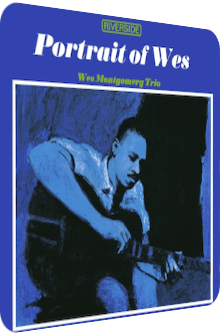
Wes Montgomery Trio
Portrait Of Wes
1963
Portrait Of Wes is the tenth album by Jazz guitarist John Leslie “Wes” Montgomery (1925–1968), released in 1963 on the back then soon to be bankrupt Riverside Records. Wes is at the helm of a trio here, with organist Mel Rhyne and drummer George Brown illumining the already blazing luminescence of the leader’s guitar chords ever-further. And this amount of audible Candela is the whole secret of – and the key to – the album’s appearance in the Exotica section, for Portrait Of Wes does unfortunately not feature exotic material, let alone particularly exotic instruments, but what it lacks in these fields, it delivers in temperature. The guitar evokes thermal heat, the organ is surprisingly transparent and cautiously texturized, with the drums and cymbals driving the structures of the respective formation without succumbing to unnecessary high-energy protuberances.
I can only speculate about the reason for the album being called Portrait Of Wes. It probably has to do with this LP being the guitarist’s tenth album; six tracks await the listener, two of them written by Wes Montgomery himself, with one track being taken from a previous album and featured here in a different arrangement (another reason for a Portrait?). Since this is the work of a trio, a certain sparseness is undoubtedly unavoidable, but cleverly bolstered and spread to feel much warmer and sunnier than the three instruments may suggest. Portrait Of Wes will never be considered by a broader range of Exotica listeners, but since it is one of my alltime Jazz favorites, mercilessly accessible, humid and still demanding, I dare to take the risk and present an in-depth review of it. You might be surprised of how exotic it is.
The album opens with a spectacularly sun-soaked scenery that is strikingly compatible with the Exotica genre and one of the primary reasons Wes Montgomery’s tenth LP is washed ashore at AmbientExotica: Miles Davis’ Freddie The Freeloader is interpreted by the trio in an enchanting version, with Montgomery’s guitar being more keen on freeform fallacies than on freeloading, with Mel Rhyne’s organ oscillating between tonalities that imply shrugged shoulders and genuinely lenient euphonies, but whatever Rhyne is presenting, it is strictly bubbling and blotchy. George Brown’s cymbals are as balmy as this golden gateway demands. A clever and possibly natural hall effect grafts a veil of phantasm onto the ebullient sunscape, making it always seem paradisiac despite the occasional presence of the nearby city.
Unfortunately, Freddie has to make room for Lolita soon enough. Originally envisioned by Barry Harris, the lady is a different kind of aural being, but no less exotic. A crossover between a distant femme fatale theme that is completely transformed by Montgomery’s polyphonic guitar globs, uplifting drums and cymbals on the one hand, and a kaleidoscopic organ helicoid of tinged madness on the other, turn Lolita around and into a diaphanous stroll at a boardwalk near the beach. Wes Montgomery’s own Movin’ Along then rounds off side A. Taken from his fifth album of the same title, the eponymous piece exchanges the alto flute spirals and piano insouciance of the original appearance and let it enter a transcendental phase via Mel Rhyne’s hyperpolished organ dobs, a greater focus on Montgomery’s guitar and – probably paradoxically so – a feistier appearance of George Brown’s drums and argentine hi-hats. Fans of the original swear by it, fair enough, but this 1963 take is again more alluring and carefree.
Side B begins the way Side A ended, with another unique Wes Montgomery piece. Dangerous is the title, and sure enough is there a kind of prowling sleaziness injected, but apart from bluer and shadier undertones that stand in contrast to the downright vivacious translucency of the former side, the Wes Montgomery Trio remains on the right track. The colors feel cooler indeed, and the downwards-spiraling organ blebs are only partially able to hide the quandary of fulfilling both nasty convulsions and genteel embracement, but at this very moment, Montgomery’s guitar solo comes into play; after three minutes, the overall tone softly changes into a milder, more clement timbre, even though the attack and decay of Brown’s drums could potentially circumvent that notion, but this depends on each listener’s viewpoint. I for one like the accessible tone sequences and their convoluted mysteries they house, whereas the latter part of Dangerous is awash with mellower lights.
The second tune of side B is a slow interpretation of Charles DeForest’s Yesterday’s Child, a Blues which is especially determined to carry the interstices and clefts in-between Montgomery’s licks into the limelight. Whisper-quiet legato drones of Rhyne’s organ waft through the mephitic air, ameliorated by Brown’s hi-hat reticulation. Hammock-friendly but too alatoric an offering, Yesterday’s Child is less about the melodies than the heterodyned interdependencies of the various frequencies and their quieter unfolding. The finale is the exquisite take on Bobby Timmons’ Moanin’, a track which makes good use of Rhyne’s organ one more time. Saltatory and bustling, it is the slightly discordant yin to Montgomery’s melodious yang. The leader of the trio shows his prestidigitation via eclectic twangs and sudden short stops of sunset chords. Being the fastest track of the whole album, backed by Brown’s lively drum and hi-hat galore, it sits right between a prolonged moment of soul searching and a life-affirming swing.
Portrait Of Wes is the perfect work for the Exotica aficionado who knows every Exotica record out there and who, in search for new gems, ventured into the adjacent Space-Age genre or even Bebop and Cool Jazz realms out of necessity a long time ago, probably in order to absorb new works that are similar to Exotica’s certain tonalities and phases. Portrait Of Wes is such a work that could please many a dedicated listener! The tracklist, the people behind the record and the instrumental base do not exactly increase the truth of my poor statement, but again, those who are in search for warm guitar chords in the veins of allstars Barney Kessel, Al Caiola, Tony Mottola and many other Exotica-related masters or Jazz guitarists will be surprised of how brightly lit and amicable Portrait Of Wes truly is. Montgomery and his guitar are unsurprisingly in the center of these events, but I am also especially fond of Mel Rhyne’s superb organ textures. This is no Hammond organ but a slightly rustier, tentatively cheekier version whose dots and specks bring many countermovements and harmonious foils to the foreground.
The only instance where it is whisper-quiet and played in legato style is on the fleeting visit of the Blues on Yesterday’s Child, a take which coincidentally is also the least impressive work due to its seemingly improvised appearance. Naturally, it is anything but improvised, the shady and dun-colored event, however, is so unlike the colorful fractals of side A. This is the small misstep of a superb six-track album which I advise to anyone who is fond of melodies entrapped in a small amount of labyrinthine segues to boost the Jazz flavor. The remastered reissue features eight tracks in total, among them the two organ-infested Alternate Takes on Moanin’ as well as the renamed Moanin’ Along, now called Blues Riff. These outtakes are worthy and long additions, and naturally, they have been remastered as well. I have provided the frame. Now it’s up to the reader to study the portrait.
Ambient Review 324: Wes Montgomery Trio – Portrait Of Wes (1963). Originally published on Mar. 15, 2014 at AmbientExotica.com.
